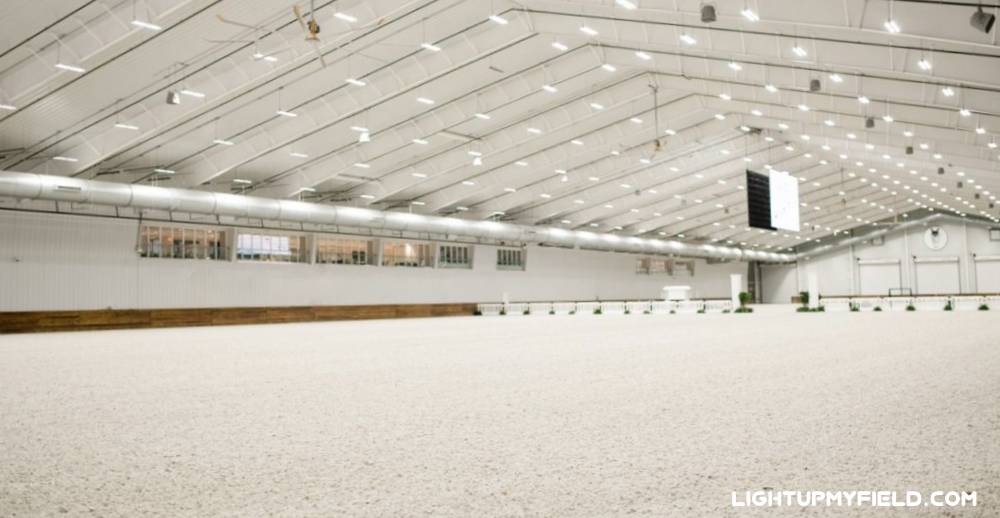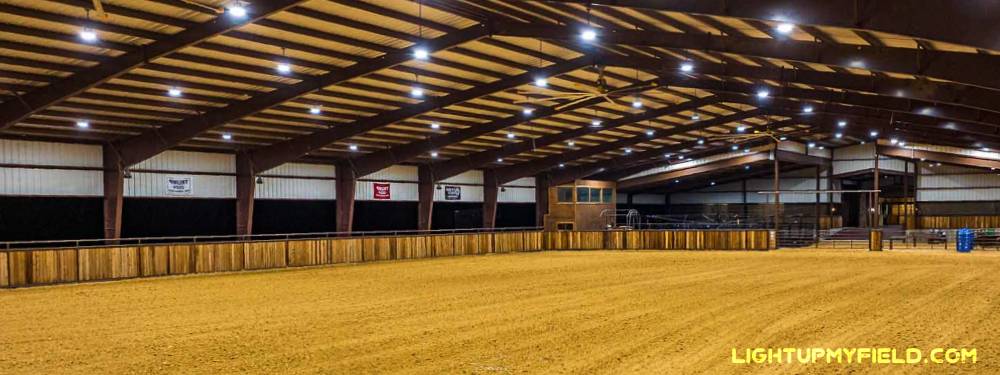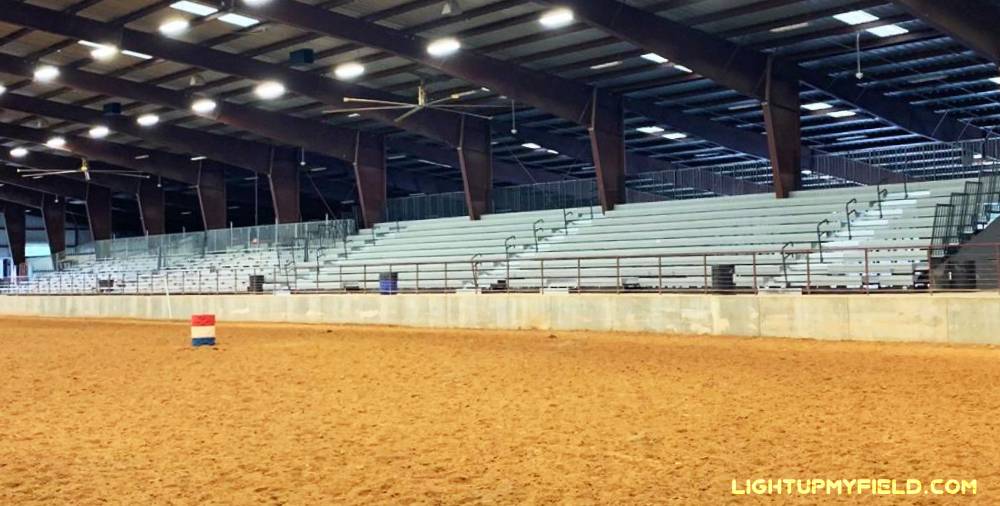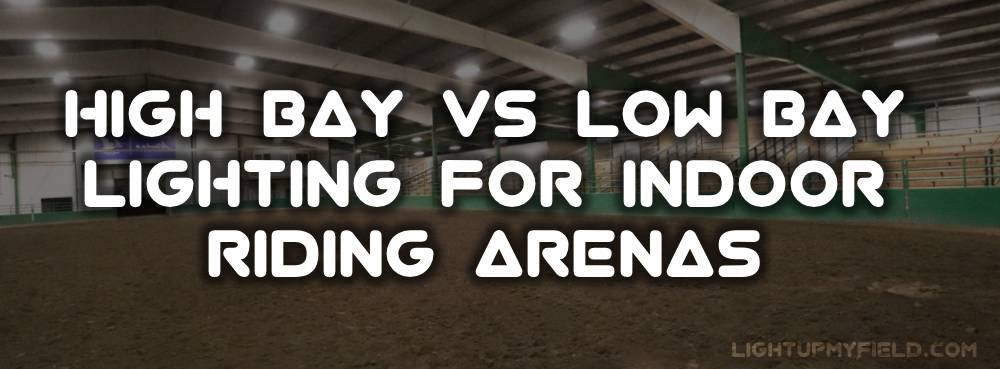Lighting can make or break the atmosphere in an indoor riding arena. Good lighting not only lets riders and horses see clearly, but it also affects safety, performance, and even the mood during training or events. If the arena is too dim, shadows and uneven brightness can cause horses to spook or riders to misjudge distances. On the other hand, overly bright or poorly aimed lights can be just as distracting. One of the most common questions arena owners ask is whether high bay or low bay lighting is the better fit for their space.
Let’s break it down so you can choose the setup that works best for your needs.
Table of Contents
ToggleSo, what exactly are high bay and low bay lights?
High bay and low bay are terms used to describe lighting fixtures based on the height at which they’re mounted.
High bay lights are generally used for ceilings that are over 20 feet (around 6 meters) from the ground. They’re designed to throw light further and more evenly across a large space. Because of the greater height, these lights usually need stronger output (often over 15,000 lumens) and narrower beam angles to direct light down where it’s needed.
Low bay lights, on the other hand, are meant for spaces with ceilings under 20 feet. They spread light more broadly and often have diffusers or wider beam angles to prevent harsh glare. Their lumen output can be lower—sometimes in the 8,000 to 12,000 range—but they can still easily make an arena bright if the spacing and aiming are right.
How do the functions of high bay and low bay compare?
High bay lighting – built for height and distance

High bay lights are designed to handle big spaces with tall ceilings—think anything over 20 feet (about 6 meters). At that height, light has to travel a long way before it reaches the ground, so the fixtures pack a stronger punch, often delivering 15,000–30,000 lumens or more. That’s bright enough to keep the riding surface evenly lit without leaving riders squinting into dark patches.
Because they’re mounted so high up, high bay fixtures usually have tighter beam angles—often in the 60° to 90° range. This focused projection helps prevent light from scattering into places where it’s not useful, like the rafters or walls. Many newer models also come with built-in reflectors or precision lenses to make sure the light is directed exactly where the horses’ hooves hit the ground.
Imagine you’re watching a showjumping round at night—good high bay lighting makes it feel like the whole arena is under a giant spotlight, but without harsh glare or blinding the riders.
Low bay lighting – softer spread for closer range

Low bay lights, on the other hand, are for spaces with ceilings between about 12 and 20 feet. They don’t need to blast out as many lumens to get the job done—something in the 8,000–15,000 lumen range is often enough. Instead of a narrow beam, they’re built to spread light more widely, sometimes with beam angles over 100°, so every corner of the arena feels evenly lit.
Because they’re closer to the riding surface, low bay lights are less about “throwing” light across a distance and more about soaking the area in an even, softer glow. This can be really nice in smaller training arenas or warm-up spaces, where you want good visibility but also a relaxed atmosphere for both rider and horse.
The “spotlight vs floodlight” analogy
If you want to picture the difference, think of high bay as a spotlight from the rafters—powerful, targeted, and meant to cover a big area from far away. Low bay is more like a floodlight from a balcony—broader, gentler, and designed to light up a space without being overpowering.
Choosing between them isn’t just about the ceiling height; it’s also about the type of riding, arena size, and brightness you’re aiming for. For example, a 20,000-lumen high bay might be perfect for a 200-foot-long competition arena, while a 10,000-lumen low bay might be plenty for a smaller lesson ring.
When’s the right time to go for high bay or low bay in an indoor riding arena?
Ceiling height – the starting point
The first thing most people look at is ceiling height, and for good reason. Light behaves very differently when it’s coming from 12 feet up compared to 25 feet. If your ceiling is over 20 feet high (about 6 meters), high bay fixtures tend to be the better choice. They throw strong, focused beams that can travel the distance without fading out halfway down. For example, a 25,000-lumen high bay light mounted at 24 feet can still deliver around 250–300 lux on the arena floor, which is bright enough for competitive jumping or reining.
This setup is especially useful for full-sized dressage or showjumping arenas—spaces that might stretch 200 feet long by 80 feet wide—where you need consistent light from one end to the other so riders don’t have to adjust their eyes every time they change direction.
When low bay makes more sense
If your ceiling height is between 12 and 20 feet, low bay lights usually fit the bill better. They’re designed to spread light wider, which means you avoid those overly intense “hot spots” directly under each fixture. That’s something both horses and riders appreciate—bright patches and deep shadows can cause distractions, especially for younger or more sensitive horses.
A 10,000-lumen low bay fixture mounted at 16 feet can comfortably give you around 150–200 lux across a smaller private arena or lesson barn. For everyday training or riding in smaller groups, that’s more than enough to keep everything visible without making the space feel harsh or washed out.
The “it depends” situations
Of course, not every arena fits neatly into a height chart. A ceiling at 19 feet might still work beautifully with high bay fixtures if you want a more focused beam and fewer lights overall. On the flip side, a 21-foot ceiling could still take low bay lights—if you choose higher wattage models and want a softer, more diffused feel instead of a competition-style brightness.
This is where other factors—like the color of the walls, how reflective the footing is, and whether you’ve got skylights—can influence the choice just as much as the height.
Riding style and brightness goals
Another big factor is the type of riding you’re doing. High-speed disciplines like show jumping, barrel racing, or reining often need brightness in the 200–300 lux range so riders can see every detail at speed. Slower-paced disciplines like dressage or groundwork might feel better at 150–200 lux, where the light is still clear but a little easier on the eyes for longer training sessions.
It’s not just about visibility—it’s about comfort, safety, and performance. Too dim, and you risk misjudged distances; too bright, and you create glare that tires everyone out faster.
| Feature | High Bay | Low Bay |
|---|---|---|
| Typical Ceiling Height | Over 20 ft (6+ m) | 12–20 ft (3.6–6 m) |
| Typical Lumen Output | 15,000–30,000+ lm | 8,000–15,000 lm |
| Common Beam Angle | 60°–90° | 90°–120° |
| Typical Lux Level (Arena Floor) | 200–300 lux | 150–200 lux |

How to get more even lighting in your riding arena
Why fixture placement matters as much as the type of light
Even if you’ve picked the perfect high bay or low bay fixtures, the lighting can still feel patchy if you don’t think about where and how you mount them. Bright spots and dark corners don’t just look bad—they can throw off a horse’s focus or make riders misjudge distances.
Beam angle – the “shape” of your light
Beam angle is a big player here. A narrower beam—around 60° to 70°—throws light further and is great for high ceilings over 20 feet. But if those fixtures are too close together, you can get intense “hot spots” on the ground that feel like mini spotlights.
A wider beam—90° or even 120°—spreads light more evenly across a larger area, which works better for lower ceilings. The catch is that too much overlap can lead to glare or a washed-out look. It’s all about balancing spread and intensity so the whole arena feels evenly lit.
Fixture spacing – avoiding light “valleys”
Spacing your lights properly is just as key as choosing the right beam angle. If you set fixtures too far apart, you’ll get shadowy valleys between the light pools. Too close, and you waste energy while creating harsh contrasts that can be just as distracting.
A handy rule of thumb is to space fixtures about 1 to 1.2 times the mounting height. So, if your lights are mounted at 20 feet, the spacing should be somewhere between 20 and 24 feet apart for good coverage.
Aiming the light where it counts
How you angle your lights can make a big difference. A slight tilt toward the riding surface—rather than pointing straight down—can help reduce glare for riders, especially near arena walls where jumps, poles, or dressage letters are placed.
Some arena owners also get creative by using light-colored or reflective wall panels. These bounce light back into darker corners, helping you get more out of the fixtures you already have.
Color temperature – setting the right mood and clarity
Most indoor arenas stick with a 4000K to 5000K color temperature because it looks bright and natural, a bit like daylight. At 5000K, colors pop more, which can help riders spot poles or markers at speed. Warmer tones—around 3000K—can make the space feel cozier, but they sometimes soften contrast, which might make it harder to see jumps or footing textures clearly.
Choosing the right color temperature isn’t just about looks—it can influence rider comfort, horse focus, and even reaction times during faster disciplines.
A few final words on making the choice
Choosing between high bay and low bay lighting for an indoor riding arena comes down to more than just fixture type—it’s really about height, beam spread, riding style, and brightness goals. Once you match the fixture to the ceiling height and fine-tune the aiming, spacing, and color temperature, you can transform the feel of the arena for both horse and rider.
The right lighting setup won’t just help you see better; it will make every ride more comfortable, safer, and more enjoyable. Whether you’re training for competition or just enjoying an evening hack indoors, getting the lighting right is one upgrade that riders (and horses) appreciate every single time they step into the arena.

